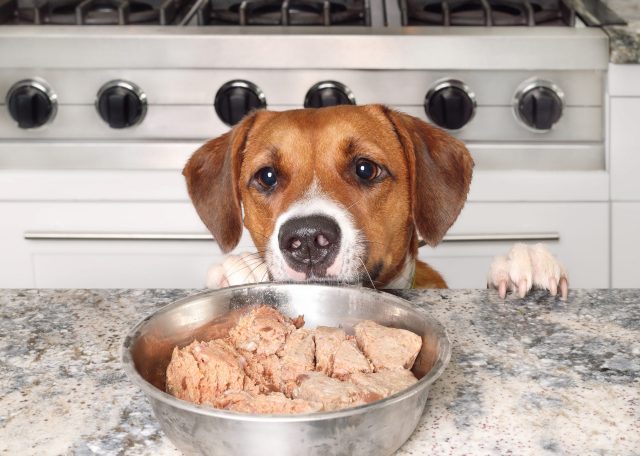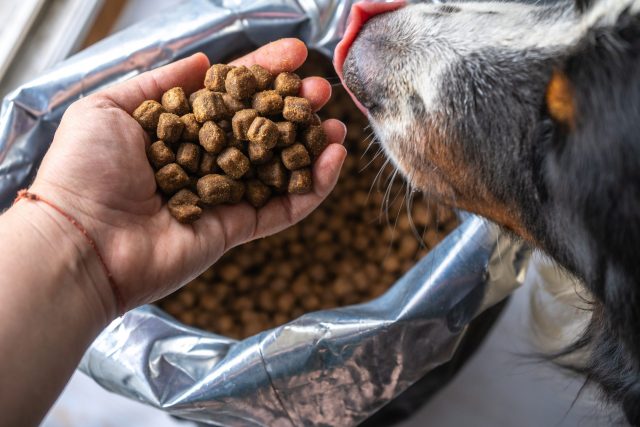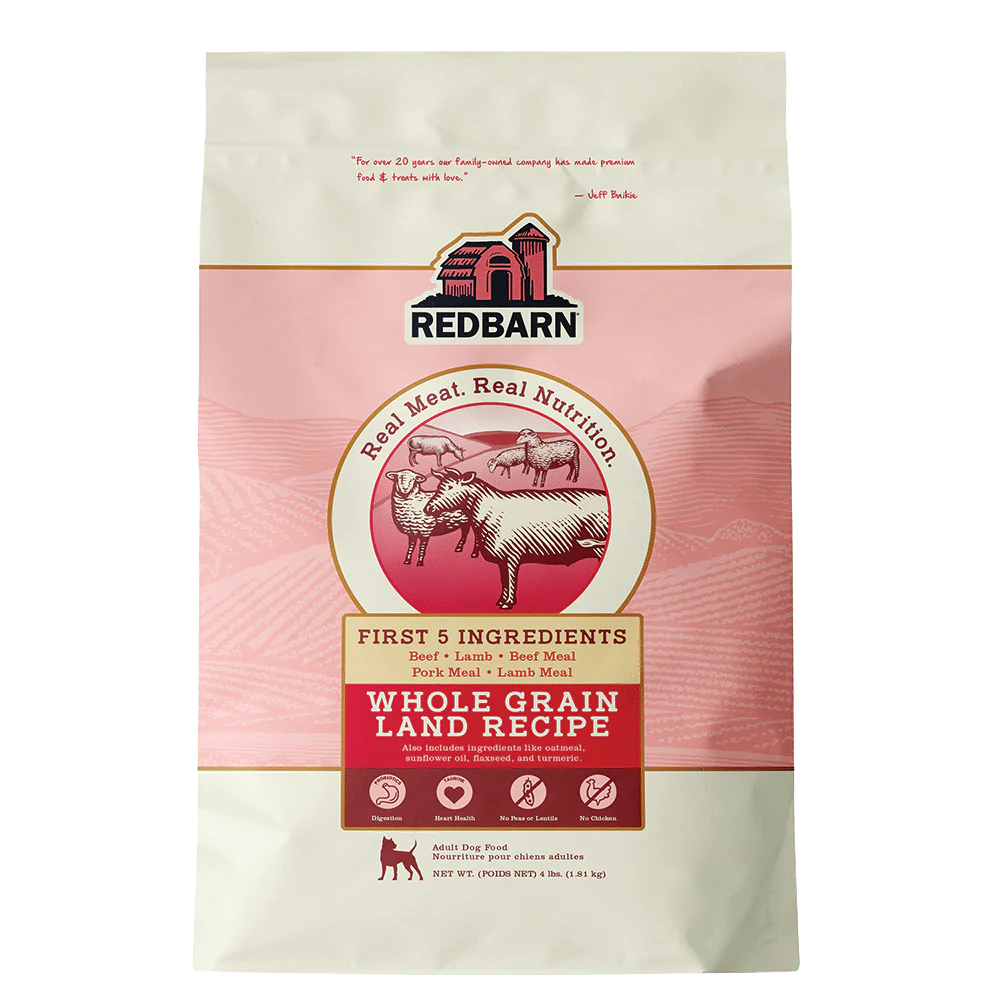iHeartDogs is reader-supported. When you buy via links on our site, we may earn an affiliate commission at no extra cost to you.
When choosing a bag of food for our pets, many of us turn to the ingredient list on the back to decide if the food is a good enough quality for our furry friends. For many dog parents, verifying that meat is the first ingredient is the only aspect they focus on. However, many pet food companies know that’s what people look for, so some ingredient lists may not be as transparent as they seem.
Keep reading to find out how to read dog food labels and choose quality food for your canine companion.
Is Meat Really the First Ingredient?
We all know dogs and cats should have meat in their diets. Most of us also agree it should be the majority of their food (especially for cats, who are obligate carnivores). And, most of us know that food ingredient labels are written with the largest “portion” ingredient first, so we all assume that if the label says a meat protein first (such as chicken, turkey, beef, etc.), then that food should be good for our pets, right?

However, not every dog food with meat as the first ingredient has lots of meat in it. The reason is that ingredients on dog food bags are listed by weight before being cooked. Meat has a lot of moisture in it, so after cooking, it loses a lot of weight. The change in weight can sometimes make it end up weighing less than other ingredients on the list. Therefore, you might not be getting exactly what you’re paying for when buying high-priced kibble.
A great way to ensure your dog is getting the meat they deserve is to also pay attention to the second and third ingredients since they could actually be the first and second ingredients after cooking. Those ingredients should also be meat sources or at least other highly beneficial items.
How to Read a Dog Food Label
Since only looking at the first ingredient isn’t effective in judging the quality of the food, it’s important to learn what all the terms on the label mean. Here are the sections of dog food labels to look at.
Product Name
What many dog parents don’t realize is that the product name can tell you something about the food’s ingredients. According to the Association of American Feed Control Officials (AAFCO), pet food products have different naming requirements depending on the food’s contents.
For example, simple names, such as “Chicken Dog Food” or Chicken for Dogs” typically have the highest meat content. Products with those types of names need at least 95% of the food’s protein to be chicken (or whatever meat is listed in the title).
If the food adds words like “dinner” or “meal” to the name, such as “Turkey Dinner for Dogs,” it only needs to have 25% of that protein or more (without surpassing 95%). If the name has the word “with,” such as “Dog Dinner with Beef,” it only needs to have at least 3% of the listed protein.

Product Weight/Quantity
The packaging will state the weight, liquid measure, or quantity, depending on the type of food. While this part doesn’t give you a lot of new information, it can help you decide if you’re getting a good value for money. For example, you can see what the cost per pound of kibble is and compare it to other brands.
Guaranteed Analysis
Dog food labels must show the following in the guaranteed analysis: protein, fat, fiber, and water. The company can choose to include other percentages, but it’s not required.
Instead of showing the exact amount of each item, the guaranteed analysis shows the minimum and/or maximum percentages. Thus, it can give you an idea of what’s included in the food, but the actual numbers will vary.
Ingredient List
The ingredient list is what we all instinctively search for on dog food bags. As mentioned earlier, the ingredients are listed in order of weight before cooking. There are a lot of varying opinions about what should and shouldn’t be included in dog food, but most dog lovers agree that having quality meat sources is an essential part of your dog’s diet.
According to the AAFCO, all the items in the ingredient list must be individual ingredients. For example, “animal protein products” is not allowed because it doesn’t specifically state what animal products are used in the food.
Aside from meat, another important thing to pay attention to on an ingredient list is your dog’s individual preferences. If your dog has allergies or sensitivities, look closely to make sure the food is free from those ingredients. For example, some dog foods that don’t have chicken as the primary protein may still include chicken fat as an ingredient, making it unsafe for dogs with chicken allergies.

Nutritional Adequacy Statement
The fine print of the dog food bag can give you a little more insight into its quality. If the packaging has statements like “complete and balanced,” that means it has met specific standards to be able to list that on the bag. Some statements may also describe the type of dogs the food is ideal for. Four life stages are recognized by the AAFCO: all life stages, maintenance, growth, and gestation/lactation.
Feeding Directions
Feeding directions are usually straightforward, but it’s important to note that these are just a suggestion, not a guideline. Feel free to adjust the serving sizes to fit your dog’s needs, especially if your furry friend needs to gain or lose weight.
Common Terms on Dog Food Bags: Which Ones Are Good?
Many dog food brands add terms to their food bags to make them more specialized or sound more appealing. In most cases, the terms don’t determine whether or not they’re beneficial because it depends on the dog’s specific needs.
Grain-Free
Grain-free dog foods have risen in popularity in recent years, but is grain-free really better? In general, grains are beneficial for a dog’s diet, so there’s typically not a need to get grain-free food unless your dog is allergic to grains. Ultimately, choosing between food with or without grains comes down to your dog’s specific needs, so when in doubt, talk to your vet for advice.

Organic
Organic makes dog food sound healthier, but that may not always be the case. There aren’t many regulations for labeling dog food as “organic,” so a lot of dog food brands can label themselves as such. In general, these foods have no artificial preservatives, colors, or flavors. They should also have no antibiotics and little to no fillers. Like grain-free food, whether or not organic food is better for your dog depends on the situation.
Human-Grade
Human-grade food is any pet food that can be legally edible for humans. Many dog parents prefer human-grade options because they follow stricter regulations to ensure they meet human food standards. However, dogs don’t have the same needs as humans, so just because a food is labeled as human-grade doesn’t automatically mean it’s healthy. Pay attention to other information on the packaging to decide if the food is high-quality.
Low-Calorie
Dog foods cannot label themselves as “low-calorie” or “low-fat” unless there are significantly fewer calories or fat compared to other products. The percentage reduction should be listed on the packaging. These types of food are best for dogs needing to lose weight or dogs with specific health concerns.
Holistic
Holistic doesn’t have a legal term and isn’t regulated in pet food, so if a package is labeled as “holistic,” it doesn’t tell you much about the food.

Items to Avoid on Dog Food Labels
While some ingredients are debatable on whether they’re good or bad for dogs, the following are generally recommended to avoid in dog food.
Certain Preservatives
The following preservatives may be dangerous for your canine companion:
- Butylated hydroxyanisole (BHA)
- Butylated hydroxytoluene (BHT)
- Monosodium Glutamate (MSG)
- Propyl gallate
- Propylene glycol
- Sodium Tripolyphosphate
- Sodium Hexametaphosphate
While these items aren’t commonly used in pet food anymore, it’s a good idea to keep an eye out for them. Many of these preservatives are also used in products like pesticides, antifreeze, and anesthesia.
Wheat, Corn, and Soy
While not as dangerous as the preservatives mentioned, corn, wheat, and soy are common allergens in dogs. Wheat may also put dogs at a higher risk of obesity while corn can be tricky to digest. Overall, they aren’t beneficial for dog foods, so it’s safer to avoid them.
Melamine
Melamine is a chemical used to artificially increase the amount of protein in dog food without adding any nutritional value. Ingesting too much of it could lead to health problems in dogs, such as kidney failure. No dog food should include this ingredient.
Rendered Fat
Rendered fat may be used to add flavor to dog food, but it’s low quality and unsafe. Not only is it often from an unknown source, but it can promote mold and unhealthy bacteria.

Cellulose
Cellulose is the equivalent of adding sawdust to your dog’s food. It makes them feel full without adding any nutritional value, so it may be used in weight management foods. However, there are safer ingredients for helping your dog lose weight.
Artificial Food Coloring/Dyes
Adding color to your dog’s food provides no nutritional benefits, so it’s best to skip it. Some dyes may even include unsafe items in them.
Corn Syrup
Corn syrup can make dog food sweeter, but there’s no nutritional benefit to adding it. It can be addictive for some dogs, causing them to eat more than they need. Some dogs may also suffer from allergies related to this ingredient.
Items to Look for on Dog Food Labels
What your dog needs in their diet can vary greatly based on their age, health, and activity level. However, the following are ingredients that are beneficial for most, if not all, dogs.

Meat
Of course, dogs need meat in their diets. Dogs are omnivores, meaning they need to eat both meat and plants. Animal sources should make up the majority of protein in your dog’s food. When looking at the ingredient list, the first three or so ingredients should be from animals to ensure that the food is packed with quality protein.
The most common meat sources in dog food are chicken, beef, pork, turkey, and fish. Choosing the best one depends on your dog’s preferences and health needs.
Fruits and Vegetables
Fruits and vegetables can be highly beneficial in a dog’s diet. Carrots, blueberries, pumpkin, broccoli, and sweet potatoes are all examples of healthy ingredients in dog food because they can provide specific health benefits like eye health, improved digestion, proper brain function, and immune health.
Grains
While some dogs have grain allergies, most dogs can benefit from healthy grains, such as brown rice, quinoa, oatmeal, and barley. Healthy grains are great sources of fiber and can help dogs with weight management. Many of these ingredients are also packed with vitamins, minerals, and antioxidants.
Healthy Fats and Oils
Fats and oils might not sound like a positive addition to dog food, but when the right ingredients are used in the right quantities, they can help your dog thrive. Specific animal fats and fish oil are great sources of omega fatty acids, which can keep your dog’s skin and coat healthy and help with growth and development.

5 Great Dog Food Brands
There are endless dog food options on the market, and there are a lot of factors to consider when making your choice. To help give you some ideas of where to start, here are five quality dog food options.
1. Ollie Fresh Dog Food
Ollie’s fresh dog food is labeled as human-grade food, but what sets it apart from the majority of dog food brands is that it can be personalized for every dog. When signing up to get Ollie food, you’ll need to fill out a questionnaire about your dog, including information like their age, weight, and nutritional needs. Then, Ollie will suggest a formula that fits your dog’s needs and give your pup a personalized serving size. The food is shipped right to your door on a set schedule. All the recipes are packed with healthy items that you can see in the food, such as meat, fruits, and vegetables.
2. Redbarn Whole Grain Land Dog Food
With the Redbarn Whole Grain Land Dog Food, the first five ingredients are all animal sources: beef, lamb, beef meal, pork meal, and lamb meal. Thus, the food will be both tasty and nutritious for your canine companion. It also includes omega fatty acids to benefit the skin and coat, prebiotics and probiotics to aid in healthy digestion, and additional ingredients to improve heart health and boost the immune system. It has beneficial grains like oatmeal and barley to ensure your dog has a well-balanced and tasty diet.
3. Sundays for Dogs
Sundays for Dogs is air-dried food so it can be shelf-stable and convenient like kibble while having the nutritional value of raw or fresh food. It only has human-grade ingredients that dogs need, such as meat, fruits, and vegetables, and it includes several meats as the first few ingredients. You can choose a beef, chicken, or turkey recipe, depending on your dog’s preferences. When ordering Sundays, you can set up a customized meal plan by filling out your dog’s information. This balanced diet is both tasty and nutritious for dogs of all breeds.
4. Taste of the Wild with Ancient Grains
Taste of the Wild is a brand known for having high-protein recipes because the formulas are meant to mimic a dog’s ancestral diet. This recipe has three animal proteins as the first three ingredients: water buffalo, pork, and chicken meal. There are also other animal sources further down the ingredient list, such as chicken fat, roasted bison, and roasted venison. So, it’s packed with a variety of nutritious flavors that dogs can enjoy. The other ingredients include superfoods and ancient grains that can benefit several areas of your dog’s health, such as their skin, coat, digestion, and immune system.
5. ACANA Red Meat Recipe
Acana is another brand known for having lots of quality animal protein. In the Red Meat Recipe, the first three ingredients are all animal proteins: beef, pork, and beef meal. The recipe contains up to 60% high-quality animal ingredients, and the other 40% consists of wholesome fruits, vegetables, and nutrients. This food has a freeze-dried coating that contains omega fatty acids to benefit the dog’s skin and coat. Then, the fiber in the food can promote healthy digestion. If your dog doesn’t care for red meat, there are other formulas available, such as free run poultry and freshwater fish.
Choosing the Right Food for Your Dog
Next time you need to choose a new dog food formula, look closely at the packaging. Good quality dog food is about more than just having meat as the first ingredient, so look closely at the label and fine print to better understand the quality of your dog’s food. Also, make sure the food is a flavor your dog enjoys while also avoiding any sensitivities they may have.





